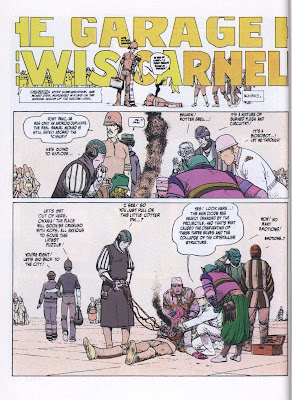'Just Got Lucky'
Fall 1983
If you turned on MTV in September 1983, it's likely that you saw the video for the single 'Just Got Lucky' by the UK group The Joboxers. The single, off their 1983 album Like Gangbusters, was released in May of 1983. The appearance of the video that Fall pushed single into the top 40 before the year's end.
It's a great song, and a great video............the little white dog in the green turtleneck sweater and tweed cap has become an iconic figure of the Music Video era..............
Your technique
It leaves me weak
My heart knows
It's the beat I seek
And I found it
(Just got lucky)
Oh yes, I found it
(Just got lucky)
I never worry
That your love is fake
I'm free and easy
And I'm feeling jake
'Cause I found it
(Just got lucky)
Oh boy, I found it
(Just got lucky)
'Cause I never felt
This way before
Like a dog always
Begging for more, yeah
I've been fooled
By love so many times
I gave up on all the silly rhymes
Kept my feelings
All inside my heart
A locked door
No key was cut
There was no fit
Now I'm such a very lucky guy
Gang way one side now
Come on here me say
We found the answer
And it's plain to see
(Come on here me say)
I'm for you and you're for me
'Cause I found it
(Just got lucky)
Together we found it
(Just got lucky)
I feel a quiver
Every time we kiss
The sky's the limit
With a love like this
'Cause I found it
(Just got lucky)
Together we found it
(Just got lucky)
'Cause I never felt
This way before
Like a dog always
Begging for more, yeah
I've been fooled
By love so many times
I gave up on all the silly rhymes
Kept my feelings
All inside my heart
A locked door
No key was cut
There was no fit
Now I'm such a very lucky guy
Gang way one side now
Come on here me say
We found the answer
And it's plain to see
(Come on here me say)
I'm for you and you're for me
'Cause I found it
(Just got lucky)
Together we found it
(Just got lucky)
I feel a quiver
Every time we kiss
The sky's the limit
With a love like this
'Cause I found it
(Just got lucky)
Together we found it
(Just got lucky)
'Cause I never felt
This way before
Like a dog always
Begging for more, yeah
I've been fooled
By love so many times
I gave up on all the silly rhymes
Kept my feelings
All inside my heart
A locked door
No key was cut
There was no fit
Now I'm such a very lucky guy
Gang way one side now
Come on here me say
Come on here me say
(Just got lucky)
(Just got lucky)
Your technique
It leaves me weak
My heart knows
It's the beat I seek
And I found it
(Just got lucky)
Oh boy, I found it
(Just got lucky)
'Cause I never felt
This way before
Just got lucky
Just got lucky
Just got lucky
Just got lucky
Just got lucky
Just got lucky
Just got lucky
Just got lucky
Just got lucky















































































.jpg)

















